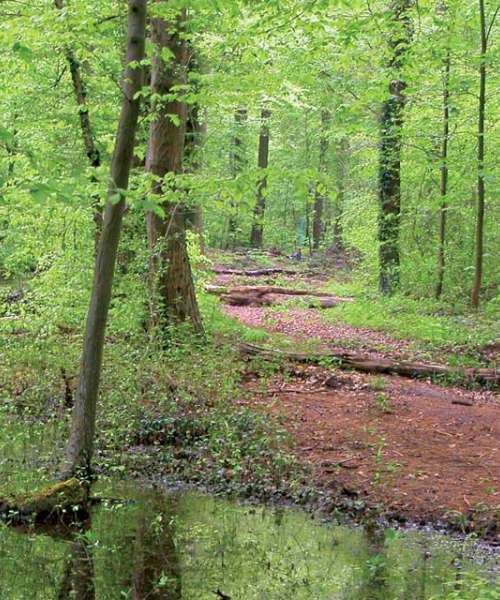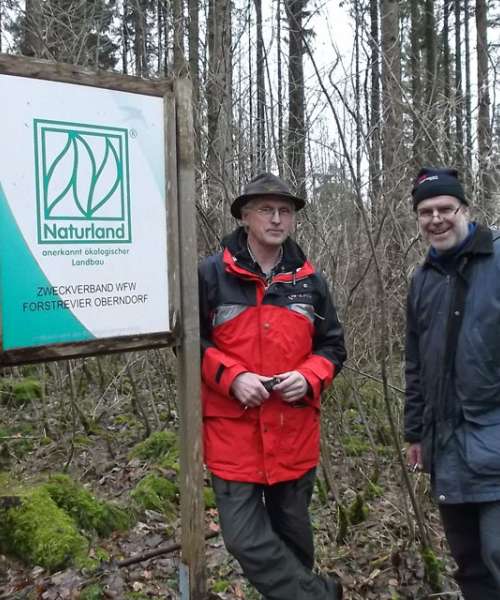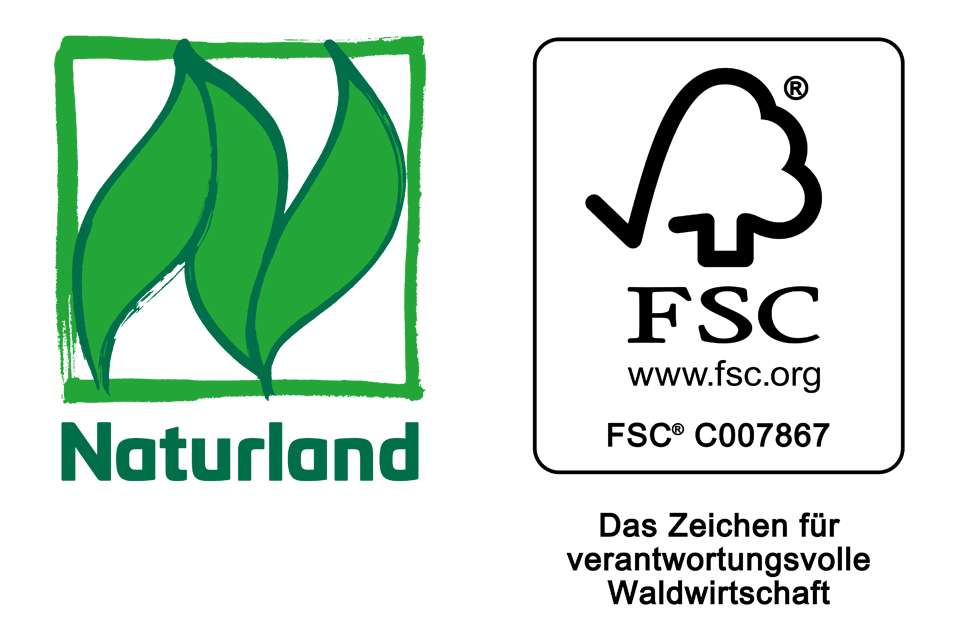forest
Organic forest use
NATURLAND FOREST AND TIMBER CERTIFICATION
The first “Naturland standards on organic forest use” were published in 1995. Our aim is to foster greater accountability for people and nature in forest management. There are currently 19 municipal and private forestry businesses across Germany managing over 53,000 hectares of forest in line with Naturland standards.
OUR FORESTS SERVE KEY PURPOSES
A third of all land in Germany is covered by forest. Even in this densely populated country, forests play a hugely important role for both people and nature. In the majority of places, trees are the natural form of vegetation and provide a habitat for a wide range of flora and fauna. They regulate the water balance, safeguard our drinking water supplies and prevent erosion, rockfall and avalanches. As well as being good for our air and the climate, they also improve the wellbeing of those seeking rest and recuperation. Forests provide a renewable supply of CO2-neutral timber and secure employment, even in areas with poor infrastructure.
Yet our forests are often far from natural. Many places are now dominated by non-native coniferous forests rather than native hardwood forests. The high demand for raw materials in the ultra-mechanised timber industry is prioritised over forest stability, quality, aesthetics and conservation. Naturland’s aim is to counteract this trend and foster greater accountability for people and nature in forest management.
Your Contact
ORGANIC FOREST USE

The “Naturland standards on organic forest use” regulate all aspects of sustainable, environmentally safe forest management. They were first developed in 1995 in conjunction with the environmental associations BUND, Greenpeace and Robin Wood with the aim of guaranteeing a credible organic certification scheme for the forestry industry.
Regular comprehensive inspections at least once every five years, spot-check assessments and annual farm report sheets ensure that our forestry businesses are rigorously controlled.
There are currently 19 municipal and private forestry businesses across Germany managing over 53,000 ha of forest in line with Naturland standards.
Our standards on organic forest use stipulate, for example, that:
- Natural forests must be regenerated and/or maintained, for example though natural forest rejuvenation, targeted planting of native tree species tailored to the local environment where possible, and by banning the planting of genetically engineered plants
- The quality of the ecosystem must be maintained by refraining from clear cutting and using pesticides or fertilisers
- The forest floor must be protected by refraining from land drainage, tillage or extensive traffic
- Careful forest development and timber harvesting techniques must be used, and game levels kept to a sustainable level
- The natural species diversity and forest dynamic must be maintained, special habitats protected and dead wood habitats (naturally ageing and dead trees) enriched
- Unmanaged reference areas must be designated in publicly-owned forests in order to obtain localised information about the natural development of the forest
Documentation on forest management and commodity flows must be clear and comprehensive
BECOME A NATURLAND MEMBER
A certification based on recognised sustainability criteria is a sought-after attribute for many forestry businesses worldwide. In Germany, Naturland set the standard for all subsequent certification systems to follow.
In order to gain a certification in line with Naturland standards, a producer (forestry business) must first become a member of and sign a producer contract with Naturland e.V. The producer contract regulates compliance with the Naturland standards and establishes the scope of inspections and data sharing.
Forestry businesses interested in gaining a Naturland forestry certification can request some preliminary information on the guideline requirements, costs, member organisation and so on from Naturland e.V. in Gräfelfing, Germany. As a next step, details of their specific circumstances are recorded and discussed as part of a no-obligation initial consultation with an adviser from Naturland's specialist forestry and timber department on implementation.
INSPECTION AND CERTIFICATION
The certification itself is then carried out by Naturland's independent certification committee. Certification is based on an inspection for compliance with the ‘Naturland standards for organic forest use’ by an independent inspection body. The inspection consists of various individual measures:
- Regular inspections of the forestry business by an independent inspection body approximately every four years
- An annual business report
- Additional spot checks and special inspections by Naturland's specialist forest and timber department
After inspection, Naturland forestry businesses receive a Naturland farm certificate and a certification decision – sometimes with appendices – from Naturland's certification committee each year.

USE OF THE NATURLAND LOGO
The Naturland logo is trademarked, publicised and recognised by consumers both nationally and internationally. On raw wood and timber products, the Naturland logo denotes that the wood is derived from organic forests. In order to use the Naturland logo in connection with marketing timber, seed, and so on, and to make any reference to Naturland, forestry businesses must also sign a sublicence agreement with Naturland Zeichen GmbH in addition to being certified by Naturland.
NATURLAND & FSC
Global issues such as the disappearance of semi-natural habitats and the degradation and even destruction of forest ecosystems call for global alliances. Consequently, as an international certification organisation and as the pioneer of organic forest use in Germany, Naturland is committed to using its expertise within the German branch of the FSC, the ‘Verein für verantwortungsvolle Waldwirtschaft e.V.’.
The FSC (Forest Stewardship Council) is a non-governmental, non-profit organisation that advocates for organic and socially responsible forest use around the world, for which it develops national and international and standards. As part of Naturland's FSC group certification coordinated by its specialist forest and timber department, participating Naturland forestry businesses commit to complying with FSC standards.
Compliance with FSC standards is verified during internal audits by Naturland's specialist forest and timber department, as well as third-party audits by the FSC's accredited certification body. For group certification participants, this means that they can market their timber with the FSC's international seal of quality in addition to the Naturland seal.

TIMBER PROCESSING FROM ORGANIC FOREST USE
True to its holistic approach, Naturland laid the foundations for certifying safe, organic processed timber products by creating a set of ‘Processing standards for timber from organic forest use’ (12/2001). Timber processors that process organically sourced timber produce sawmill products, wood-based materials and off-the-shelf wood products using environmentally friendly methods.
In doing so, they build on the organic forestry sector's efforts to sustain the natural life support systems of plants, animals and humans, thus enabling them to play an active role in protecting the earth's environment and resources. Naturland is currently in the process of establishing a group of certified timber processors.
Compliance with the following standards, among others, will be examined during annual inspections:
- Use of timber from Naturland forestry businesses (alternatively FSC-certified timber)
- Controlled commodity flow from certified forestry business through to finished timber product (e.g. separate storage and manufacturing processes for certified and non-certified goods).
- Production of safe timber products by:
- Refraining from the use of synthetic storage and timber protection products and biocides
- Refraining from the use of nickel-containing metals and hazardous ingredients in adhesives and glues (e.g. formaldehyde)
- Using solvent-free and low-solvent paints made from renewable raw materials
- Using natural or polyvinyl acetate (PVA) glues
- Using resource-efficient timber processing methods, such as:
- Using renewable raw materials (no plastics)
- Energy-saving timber drying processes, using renewable energy sources where possible
Environmentally friendly packaging and the shortest transport routes possible




